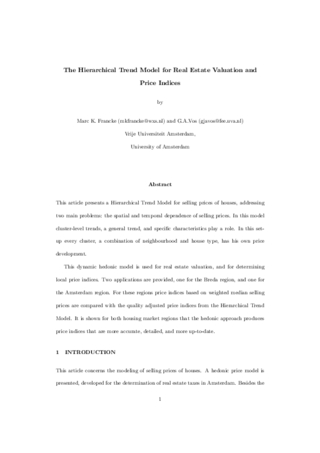This paper presents and describes a hedonic price model, the Hierarchical Trend Model (HTM) for selling prices of houses. In a time of rapid price movements, the selling date is an important characteristic to explain selling prices, besides the size, and the location of the house. In this model cluster-level trends (for market segments), the general trend, and specific characteristics all play a role. Combined with the influence of the specific characteristics these trends are estimated within the model. The cluster-level trends are specified as deviations from the general trend. The general, and cluster-level trends are modelled as stochastic trends, so no a priori structure is assumed. The clusters, or market segments can be defined as, for example, neighbourhoods, and dwelling types. In this set-up every market segment has its own price development. This model can be used for real estate valuation. Given the characteristics of the house, the model is able to produce values for all time points in the time period under consideration. At the present moment this model is operational in Amsterdam for the determination of real estate taxes. Some empirical results are shown for the Amsterdam Region. Another application is found in the determination of price indices. Changes in the levels of selling prices can be caused by changes in the underlying characteristics of the houses. For this reason selling price levels in one period cannot simply be compared to selling price levels in another period, but the levels need to be adjusted for differences in house characteristics. It is shown that the estimated trends from the HTM provide the correct measurement of house price movements and price levels over time. The indices produced by the HTM are compared to indices from an often-used method, which simply consists of taking averages, or medians for every cluster. The research is based on data of housing market transactions in the Amsterdam Region, and in the Breda Region over the period 1985-1999 from the Dutch Broker Organisation NVM. This paper states, and empirically proves that for both Housing market Regions the Hedonic approach produces price indices which are more accurate, detailed, and more up-to-date. For both methods standard deviations are compared for price indices for the region as a whole as well as per neighbourhood, and for house type within the region, both on a monthly, quarterly, and a yearly basis.
Francke, M.K., and Gerjan A. Vos. "The Hierarchical Trend Model for Real Estate Valuation and Price Indices." In 8th European Real Estate Society Conference. ERES: Conference. Alicante, Spain, 2001.
Section: Estimation Technics in Real Estate
